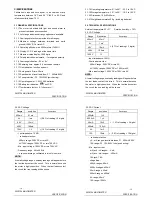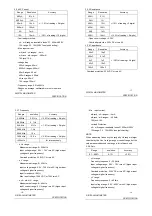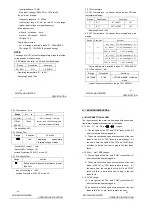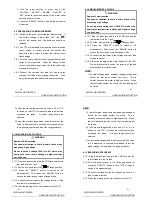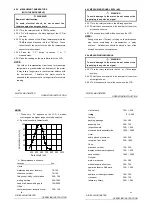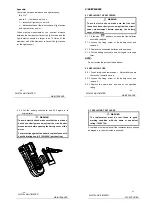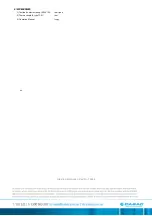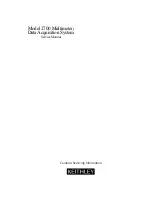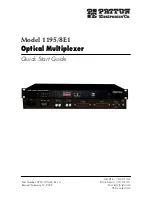
4.10 MEASURING
DC
VOLTAGE
…29
4.11 MEASURING
AC
VOLTAGE
…30
4.12 MEASURING
FREQUENCY
…31
4.13 MEASURING
DUTY
…32
4.14 MEASURING
DC
CURRENT
…32
4.15 MEASURING
AC
CURRENT
…33
4.16 MEASURING
RESISTANCE
…35
4.17 MEASURING
CAPACITANCE
…36
4.18 TESTING
DIODE
…36
4.19 TESTING
CONTINUITY
…37
4.20 MEASURING RELATIVE HUMIDITY
…38
4.21 MEASURING
TEMPERATURE
(WITH THERMO-RESISTOR)
…39
4.22 MEASURING
TEMPERATURE
(WITH THERMOCOUPLE)
…40
4.23 MEASURING SOUND LEVEL (dB)
…41
4.24 MEASURING
LUMINANCE
…41
5.
MAINTENANCE
…45
5.1 REPLACING THE BATTERIES
…45
5.2 REPLACING FUSE
…45
5.3 REPLACING TEST LEADS
…47
6.
ACCESSORIES
…48
DIGITAL MULTIMETER
SAFETY
INFORMATION
1. SAFETY INFORMATION
WARNING
BE EXTREMELY CAREFUL WHEN USING THIS
METER. Improper use of this device can result in
electric shock or destruction of the meter. Take all
normal safety precautions and follow the safeguards
suggested in this manual.
To exploit full functionality of the meter and ensure
safe operation, please read carefully and follow the
directions in this manual.
This meter complies with the general technical requirements
for the GB/T 19978-92 multimeter as well as the safety
requirements for GB4793.1-1995 (IEC-1010-1:1990)
concerning electronic measuring instruments, with pollution
degree 2 and overvoltage at CAT
ΙΙ
1000V/ CAT
ΙΙΙ
600V.
Follow all safety and operation instructions to ensure safe
use of the meter.
With proper use and care, this digital multimeter will give you
years of satisfactory service.
1.1 PRELIMINARY
1.1.1 When using the meter, the user must observe all
normal safety rules concerning:
1) general protection against electric shock
2) protection of the meter against misuse
- 1 -
DIGITAL MULTIMETER
SAFETY
INFORMATION
1.1.2 When the meter is delivered, check whether it has
been damaged in transit.
1.1.3 After being stored and delivered under harsh
conditions, the meter should be checked and
confirmed whether any damages have been incurred.
1.1.4 Test leads must be kept in good condition. Check
whether the insulation on test leads has been
damaged and any wire has been exposed.
1.1.5 Use the test leads supplied to ensure operation safety.
If required, they must be replaced with test leads of the
same model or class.
1.2 DOS AND DON’TS
1.2.1 Use the right input jack, function and range.
1.2.2 Do not take measurements that exceed the protection
limit values indicated in the specifications
1.2.3 Do not touch the metal tips of the test leads when the
meter is connected to the circuit to be measured.
1.2.4 Keep your fingers behind the probe barriers when
taking a measurement with an effective voltage above
60V DC or 30V rms AC.
1.2.5 Do not take voltage measurement if the value between
the terminals and earth ground exceeds 1000V.
1.2.6 Select the highest range if the value scale to be
measured in the manual range is unknown.
- 2 -
DIGITAL MULTIMETER
SAFETY INFORMATION
1.2.7 Do not connect the meter to any voltage source while
the rotary selector is in the current, resistance,
capacitance, diode, continuity range.
1.2.8 Disconnect the test leads from the circuit under test
before turning the rotary selector to change functions.
1.2.9 Be careful that high voltage pulses at test points may
damage the meter when measurements are being
taken on the circuit of TV switch power.
1.2.10 Do not measure the resistance
,
capacitance, diode or
continuity of live circuits.
1.2.11 Do not take capacitance measurements until the
capacitor to be measured has been fully discharged.
1.2.12 Do not use the meter near explosive gases, steam or
dirt.
1.2.13 Stop using the meter if any abnormalities or faults are
observed.
1.2.14 Do not use the meter unless its rear case is securely
fastened in its original position.
1.2.15 Do not store or use the meter in areas exposed to
direct sunlight, at high temperature or with high relative
humidity.
1.3 SYMBOLS
- important safety information; refer to the operation
manual.
- dangerous voltage may be present.
- 3 -
DIGITAL MULTIMETER
SAFETY INFORMATION





